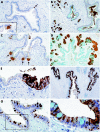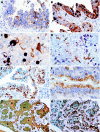Liver fluke-associated and sporadic cholangiocarcinoma: an immunohistochemical study of bile duct, peribiliary gland and tumour cell phenotypes
- PMID: 16679351
- PMCID: PMC1861757
- DOI: 10.1136/jcp.2005.033712
Liver fluke-associated and sporadic cholangiocarcinoma: an immunohistochemical study of bile duct, peribiliary gland and tumour cell phenotypes
Abstract
Aim: To compare cell phenotypes displayed by cholangiocarcinomas and adjacent bile duct lesions in patients from an area endemic in liver-fluke infestation and those with sporadic cholangiocarcinoma.
Methods: 65 fluke-associated and 47 sporadic cholangiocarcinomas and 6 normal livers were studied. Serial paraffin-wax sections were stained immunohistochemically with monoclonal antibodies characterising a Brunner or pyloric gland metaplasia cell phenotype (antigens D10 and 1F6), intestinal goblet cells (antigen 17NM), gastric foveolar apomucin (MUC5AC), a gastrointestinal epithelium cytokeratin (CK20) and the p53 protein.
Results: 60% of the 112 cholangiocarcinomas expressed antigen D10, 68% MUC5AC, 33% antigen 17NM and 20% CK20; 37% showed overexpression of p53. When present together in a cholangiocarcinoma, cancer cells expressing D10 were distinct from those displaying 17NM or MUC5AC. Many more fluke-associated cholangiocarcinomas than sporadic cholangiocarcinomas displayed 17NM and p53 expression. Most cases of hyperplastic and dysplastic biliary epithelium expressed D10 strongly. Pyloric gland metaplasia and peribiliary glands displayed D10 and 1F6, with peribiliary gland hyperplasia more evident in the livers with fluke-associated cholangiocarcinoma; goblet cells in intestinal metaplasia stained for 17NM. No notable association of expression between any two antigens (including p53) was found in the cancers.
Conclusions: Most cases of dysplastic biliary epithelium and cholangiocarcinoma display a Brunner or pyloric gland cell phenotype and a gastric foveolar cell phenotype. The expression of D10 in hyperplastic and dysplastic epithelium and in cholangiocarcinoma is consistent with a dysplasia-carcinoma sequence. Many more fluke-associated cholangiocarcinomas than sporadic cholangiocarcinoma display an intestinal goblet cell phenotype and overexpress p53, indicating differences in the aetiopathology of the cancers in the two groups of patients.
Conflict of interest statement
Competing interests: None.
References
-
- Haswell‐Elkins M R, Satarug S, Elkins D B.Opisthorchis viverrini infection in North East Thailand and its relationship to cholangiocarcinoma. J Gastroenterol Hepatol 19927538–548. - PubMed
-
- Srivatanakul P, Sontipong S, Chotiwan P.et al Liver cancer in Thailand: temporal and geographic variations. J Gastroenterol Hepatol 19883413–420.
Publication types
MeSH terms
Substances
LinkOut - more resources
Full Text Sources
Medical
Research Materials
Miscellaneous


